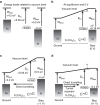A 17 GHz molecular rectifier
- PMID: 27694833
- PMCID: PMC5059435
- DOI: 10.1038/ncomms12850
A 17 GHz molecular rectifier
Abstract
Molecular electronics originally proposed that small molecules sandwiched between electrodes would accomplish electronic functions and enable ultimate scaling to be reached. However, so far, functional molecular devices have only been demonstrated at low frequency. Here, we demonstrate molecular diodes operating up to 17.8 GHz. Direct current and radio frequency (RF) properties were simultaneously measured on a large array of molecular junctions composed of gold nanocrystal electrodes, ferrocenyl undecanethiol molecules and the tip of an interferometric scanning microwave microscope. The present nanometre-scale molecular diodes offer a current density increase by several orders of magnitude compared with that of micrometre-scale molecular diodes, allowing RF operation. The measured S11 parameters show a diode rectification ratio of 12 dB which is linked to the rectification behaviour of the direct current conductance. From the RF measurements, we extrapolate a cut-off frequency of 520 GHz. A comparison with the silicon RF-Schottky diodes, architecture suggests that the RF-molecular diodes are extremely attractive for scaling and high-frequency operation.
Figures




References
-
- Tonouchi M. Cutting-edge Terahertz technology. Nat. Photon. 1, 97–106 (2007).
-
- Editorial. Terahertz optics taking off. Nat. Photon. 7, 665–665 (2013).
-
- Ratner M. A brief history of molecular electronics. Nat. Nanotechnol. 8, 378–381 (2013). - PubMed
-
- Ke S.-H., Liu R., Yang W. & Baranger H. U. Time-dependent transport through molecular junctions. J. Chem. Phys. 132, 234105–234111 (2010). - PubMed
-
- Xiang D., Wang X., Jia C., Lee T. & Guo X. Molecular-scale electronics: from concept to function. Chem. Rev. 116, 4318–4440 (2016). - PubMed
Publication types
LinkOut - more resources
Full Text Sources
Other Literature Sources
Miscellaneous

